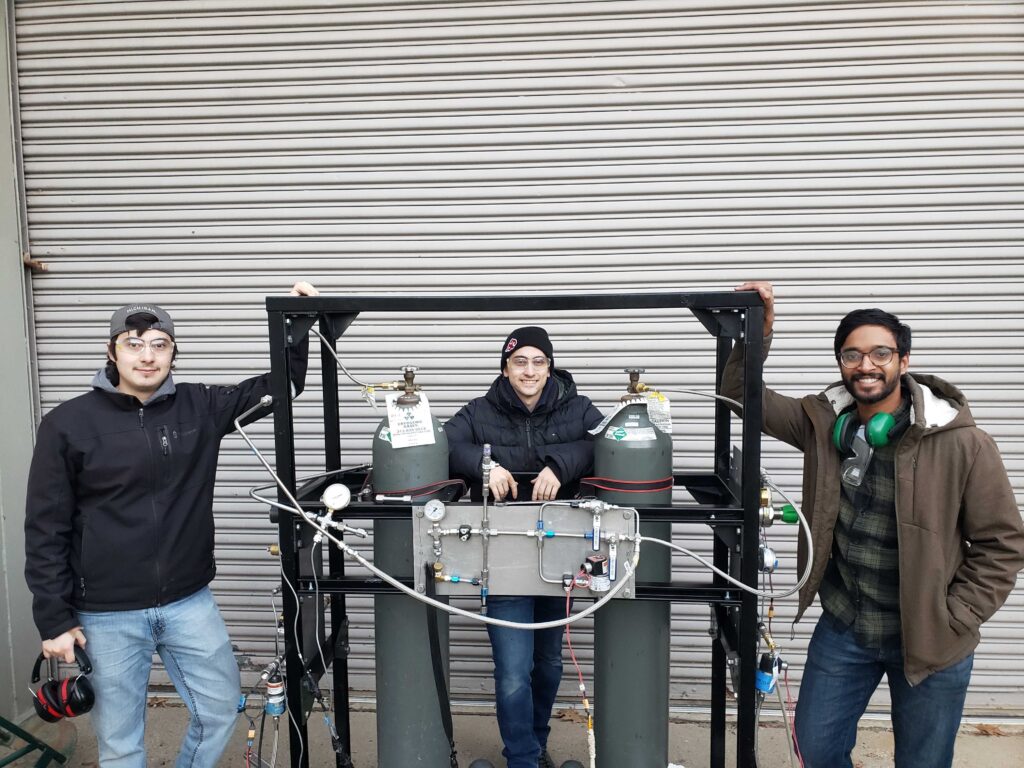
Igniting Engines
Michigan Aerospace Seniors Develop and Test Methane-Oxygen Torch Igniter for future MASA Rockets

Michigan Aerospace Seniors Develop and Test Methane-Oxygen Torch Igniter for future MASA Rockets
Three Michigan Aerospace seniors used their Aerospace 405 senior design project to design, build, and test a methane-oxygen torch igniter for the Michigan Aeronautical Science Association (MASA) at the University of Michigan. Sergio Cereceres, Igor Khalip, and Joshua Thomas joined together this past September to address critical ignition issues faced by MASA as part of the group’s rocket development efforts, specifically in regards to igniting their rocket engines.

In a rocket engine, a substantial amount of energy is necessary to initiate the combustion of liquid oxygen and the rocket propellant directed into the chamber. The team’s previous method involved employing ammonium perchlorate composite propellant (APCP) pucks, also known as solid propellant. This solid rocket chemical is activated through a small fuse. Expanding on this, the team highlights a significant challenge associated with APCP — its hazardous manufacturing process. The MASA team encountered previous incidents where individuals unintentionally initiated fires or had experience with the APCP puck in their engines never going off.
“We had this really annoying, really unreliable and dangerous igniter material that we had been working with, so I decided it is time to move onto something that is more reliable, safer and efficient to work with, and that is why I decided on the torch igniter,” Josh explained. The team recognized the need for a new ignitor for the MASA rockets, leading them to explore the industry-standard torch igniter used by major industry leaders like SpaceX, NASA, and Blue Origin.

The torch igniter, characterized as a metal piece that utilizes oxygen and methane to create ignition through a spark plug, promised enhanced safety and efficiency. In contrast to the one-time use limitation of APCP pucks, the torch igniter allowed for multiple ignitions by refilling the propellant after each use. The team divided responsibilities, with Josh handling the feed system, Sergio working on avionics, and Igor focusing on the igniter design. “We all pitched in an insane amount of work. I would say close to 20 to 25 hours a week to get this thing done. The torch igniter itself is beautiful, the feed system was good and got us where we needed to be, and the avionics system was beautiful as well,” stated Josh.
Josh elaborates on the rollercoaster journey of the project, emphasizing the numerous challenges they faced. “There were times their manufacturing was wrong and they had to have a part welded instead of tapped. There were times where different valves on the feed system broke and they had to replace different regulators.” He continued on to say, “The theme of our project is never give up, even if things go wrong and things really are not looking good and the timeline is slipping further and further. It doesn’t mean you should pack your bags and go home. It means it is time to maybe take a 15 minute break and come back with a fresh set of eyes and never give up and always power through your failures.”
MASA is the student-run rocketry team at the University of Michigan, bringing together students to design, build and launch liquid-fueled rockets. Composed of 7 subteams, members have come together to build countless rockets over the last 20 years and grow in all aspects of engineering, business, outreach, and leadership. Their most recent rocket, Clementine, successfully launched in May of 2023 and holds the record for the nation’s largest student-built liquid bipropellant rocket.
While the team does not intend to implement the torch igniter on the upcoming MASA rocket, Limelight, they express optimism about its potential integration into future rocket engines. “I believe there are still some refinements that need to be done (before being used on a MASA rocket engine). It needs to be smaller, lighter, before it can confidently go on a flight vehicle,” commented Josh. Building off of that, Sergio went on to say, “We have not been able to test the torch igniter on an engine which is why we couldn’t recommend that MASA use it just yet, until it has been optimized or tested for an engine.”
The culmination of their efforts resulted in 10 hot fire attempts, with an impressive 7 successful hot fires, lasting a total of 12 seconds. The trio celebrated the accomplishment, describing it as “incredible for any type of system, let alone something that we designed and tested in a semester.”
The Michigan Aerospace seniors’ innovative approach to address ignition challenges demonstrates their commitment to advancing aerospace technology. Their methane-oxygen torch igniter not only overcame limitations of existing materials but also showcased the power of perseverance and collaboration in achieving significant milestones.